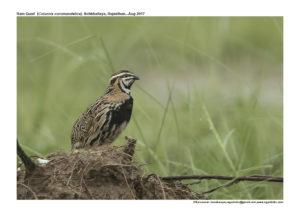Rain Quail

Rain Quail Cotournix coromandelica
Etymology:
- Coturnix : Latin word for quail
- Coromandelica : Coromendal coast India
Vernacular names: Hindi: China bater, GobalBater, Nepal: Chanak, Guj: Chinagabater, Varshalavri, Ta: Kaadai, Te: Chinnayellichi, Burrlakka (for all quails in Kurnool distict), Mal: Kata, Sinh: Pun watuwa, Wilwatuwa, Mar: Varsha Lawwa
Distribution in India: Resident in Central and West India. Summer Visitor in North West and winter visitor in East and Peninsular India
Description: Size of 16–18 cm; wt. of 64–85 g.The male has a black breast-patch and distinctive head pattern of black and white, lacks barring on primaries. The bill is blackish for male in breeding season or dusky brown with paler base; irides brown; legs fleshy pink to greyish flesh. The female is difficult to separate from female common quail and Japanese quail, although the spots on the breast are more delicate. The young male has less prominent markings on throat and breast
Habitat: It is found in grassland, cultivation (including tea plantations and dry rice fields), dry scrub, meadows, gardens and scrub jungle, up to c. 2500 m but while breeding only up to 1800 m.
Food Habits: It eats grass and weed seeds, and insects. They are often recorded in small flocks.
Breeding Habits: They breed in Mar–Oct (mainly Aug–Oct), but may vary according to local rainfall in India.They are monogamous. They nest in crops or grass, sometimes in scrub or bush, a shallow scrape lined with dry grasses and constructed by female. They lay a clutch of 4–6. The incubation period is 18–19 days done by female only. Male also assists in tending to the chicks.